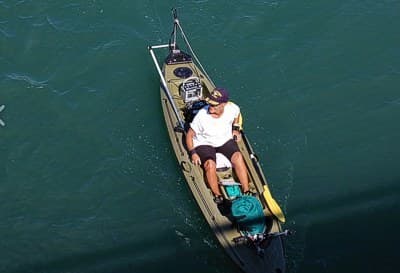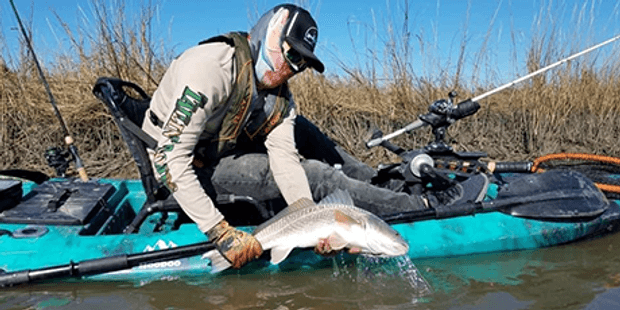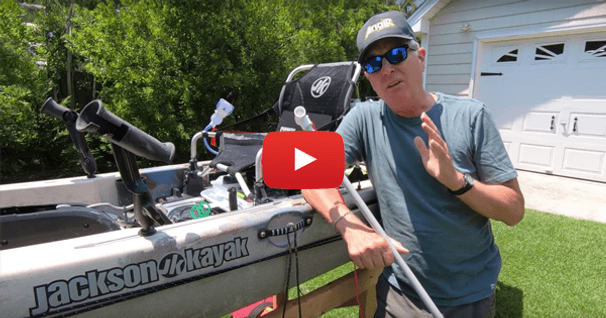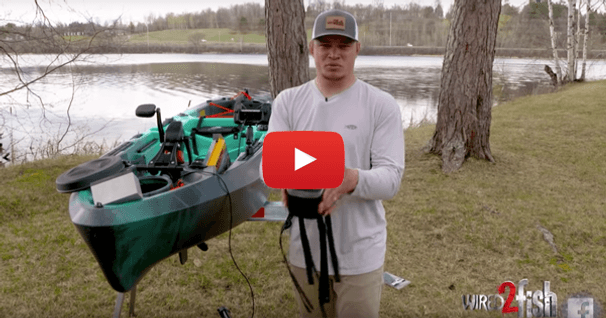Kayak Fishing Gear Review: Trolling Motor
One of the main reasons I still love paddle angling is the simplicity. Pretty much, you just throw the boat in the water and go. However, this simple sport gets complicated when you start forcing your kayak or canoe to do things it wasn't designed to do. It wasn't meant to haul 400 lbs of camping gear. It wasn't meant to carry 15 rods and enough gear for every imaginable angling opportunity. And, with few exceptions, the typical canoe or kayak wasn't meant to accommodate a trolling motor.
Paddle angling has always been about the benefits outweighing the obstacles. When it comes to adding a trolling motor to a paddle craft the same issues come in to play. You can make your own pros/cons list, because some of the "cons" might not be cons to you, if the "pros" are big enough.
If you phrase the question properly, the Internet will bury you with some very crafty trolling motor/mount answers, many of these solutions are things that you can do yourself. I spent a lot of years building things and creating my own solutions. But "years" is a measurement of time, and frankly, I'd rather spend my time fishing and leave the solutions to the folks that make a livelihood on such solutions. Plus, I never offer any sort of warranty on my work. With that being said, I looked no further than our own Paddling.Net and found a solution. Done.
As the answers started coming back, it became clear that in order to make all of this work, you'd need to get some pieces together: • Motor mount • Electric trolling motor • 12v marine battery
It also became clear that you'd have to do a lot of guestimation to see which components would work with each other ... Or, you could just go and check out: The Skimmer Kayak Propulsion System
~Fishing Kayaks from Hoodoo Sports~
Looking for a high quality fishing kayak at a reasonable price? Check out Hoodoo's lineup featuring the new dual-drive Impulse.
THE MOTOR MOUNT:
This is where the whole process starts. Every component from here on only compliments a smart selection in the motor mount category. I did find some pretty creative solutions out there, but if you really want to have the feel and control of a powered vessel (since that's what your goal ~really~ is) then the motor should mount on the stern. Side mounts will be functional, but if you're going to take this step, might as well travel in the right direction.

The Skimmer website offers some great videos on how to mount the 2 styles of motor mounts, but let me make it easy for you. (1) You secure a mounting bracket to the kayak with two (2) stainless steel bolts. I'll pause a moment so you can reflect on this degree of difficulty. OK, that's done. The motor mount secures to that plate so the motor can easily be removed as needed. You may relax now - the hard part is over.
THE ELECTRIC TROLLING MOTOR: This obviously will be a personal decision. Do you want something smaller so it will use less battery, or do you really want your kayak to scream? Face the fact that a displacement hull on a kayak will only go so fast. It's not like a planing hull on a boat that will enable you to go faster once a certain speed is reached and the hull gets on top of the water. And, trolling motors aren't designed to facilitate getting on plane in the first place. If you already have a trolling motor and you're building your solution around that, then you may find that a home grown side mount solution may not allow your motor to really perform as it did on a boat. The Skimmer electric motor obviously is paired with the rest of the kit to maximize potential. The Skimmer motor has 17 lbs of thrust, which is plenty of power. The motor will run up to 5 hours depending on what battery you select.
STEERING: With a side-mount system, you can control direction and speed from the motor itself. Make no mistake; this approach will probably push the kayak as fast as it will be able to physically go anyway. But the Skimmer steering system is nothing short of slick. It uses a simple push/pull = right/left steering mechanism, and the throttle is on/off. Simple.

So, "how much is all this" you ask? "Prices subject to change", and all those other legal loopholes, here's what you get:
- 17 lb thrust (200 watt) trolling motor for fresh and salt water
- Plug in wire controls with waterproof on/off toggle switch
- Tiller style steering - Anodized high quality aluminum - Extends 3-7 ft to accommodate all kayak/canoe sizes
- Motor Lifting system for shallow water
- Easy Install Propeller
- Mounting Plate - Waterproof Marine Board
- All Stainless Steel Hardware
$397.00 (until 5/1/13)
Shipping: U.S. $25.00, AK, HI, or other; call them.
In this day and age, this is a pretty good return on the investment.
THE BATTERY: No getting around this one ... if you're going to have electric devices on your kayak, you will need a 12v marine battery. If you have a fish finder already then you're half of the way there. If not, you can get 2 batteries and charger for around $55 from Cabela's. Once you have 12v power onboard this opens up all sorts of other gadgetry, should you be so inclined.
THE GOVERNMENT / REGISTRATION: Now that you are a boat in the eyes of the law, you may need to have your kayak registered. In my home state of Florida, the law says:
- All vessels, with the exception of non-motor-powered vessels less than 16 feet in length, non-motor-powered canoes, kayaks, racing shells or rowing sculls, regardless of length, must be registered through your local Tax Collector's Office.
- Letters must be separated from the numbers by a hyphen or space equal to letter width.
- The Certificate of Registration must be on board and available for inspection by an enforcement officer whenever the vessel is operated.
- Vessels must be registered and numbered within 30 days of purchase.
- Registration numbers must be displayed on the forward half of the vessel on both sides above the waterline.
- The numbers must be bold block letters at least 3" high in a color contrasting to the hull.
- The vessel registration decal must be renewed annually and is to be displayed within 6 inches of, either before or after, the registration numbers on the port (left) side.
So, whenever the trolling motor is attached, the kayak must display registration numbers as well as the annual decal. Check with your Tax Collectors Office to be sure, and understand that there will most likely be fees associated with registration.
There are many online resources for the registration numbers. Understand that the decals will only adhere to a smooth surface, so keep that in mind as you determine where the decals should be placed in order to be legal.
Once you have any trolling motor solution in place, I highly advise you to take a day and just run the motor while being on a familiar area. This way you will know what sort of lifetime your battery will have. That way you can plan your next outing with more confidence.
See you out on the water ...
"Many men go fishing all of their lives without knowing that it is not fish they are after"
~ Henry David Thoreau
Related Articles
Learn to make a good DIY stake out pole so you can save some money for other kayak updates!
Learn how to install a fish finder on your fishing kayak without compromising your yak by drilling holes…
I had an opportunity last week to go on a different type of fishing adventure. This trip would be to…
Fishing from a "touring" kayak, whether it be a sleek, blue-water craft or a broad and stable "rec"…



